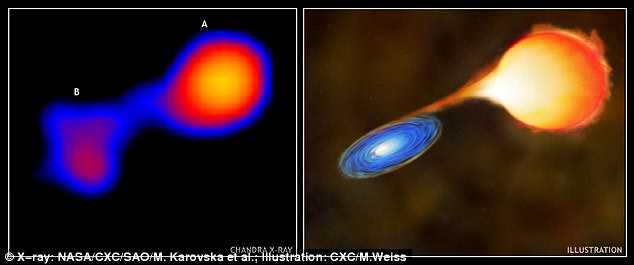Symbiotic stars
Many, perhaps even most stars, are members of binaries -- two stars that orbit each other. Symbiotic stars are a small subset of binaries with an attitude: they display characteristic, dramatic, episodic changes in the spectra of their light because (it is thought) one star of pair is a very hot, small star while the other is a cool giant (from PhysOrg.com).
Most red giants are placid and calm, but some pulsate with periods between 80 and 1,000 days like the star Mira and undergo large changes in brightness.
This subset of red giants is called 'Mira variables.' The red giant in R Aqr is a Mira variable and undergoes steady changes in brightness by a factor of 250 as it pulsates, unlike its white dwarf companion that does not pulsate. There are other striking differences between the two stars. The white dwarf is about ten thousand times brighter than the red giant.
The white dwarf has a surface temperature of some 20,000 K while the Mira variable has a temperature of about 3,000 K.

Chandra's image shows Mira A (right), a highly evolved red giant star, and Mira B (left), a white dwarf. To the right of the image is an artist's conception of this interacting star system. Mira A is losing gas rapidly from its upper atmosphere via a stellar wind. Mira B exerts a gravitational tug that creates a gaseous bridge between the two stars. Gas from the wind and bridge accumulates in an accretion disk around Mira B and collisions between rapidly moving particles in the disk produce X-rays.

CH Cyg
- 2018-08-15
- Alpy600
- 8" Newton f/4
- Atik 414
- Site: Berlin Germany

CH Cyg H-alpha
- 2018-06-30
- L200 Spectrograph 1800 grating 29µ slit
- ASI1600 MM 2x2 bin
- Site: Berlin, Germany

CI Cyg
- 2019-08-05
- Alpy600
- 8" f/4 Newton
- Atik 414
- Site: Berlin , Germany